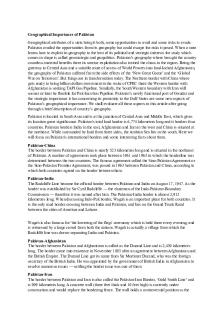Pakistan studies Assignment 3 project (Evolution of Industries since creation of Pakistan) PDF

| Title | Pakistan studies Assignment 3 project (Evolution of Industries since creation of Pakistan) |
|---|---|
| Author | Quratulain sajid |
| Course | Pakistan Studies |
| Institution | COMSATS University Islamabad |
| Pages | 18 |
| File Size | 589 KB |
| File Type | |
| Total Downloads | 35 |
| Total Views | 145 |
Summary
Download Pakistan studies Assignment 3 project (Evolution of Industries since creation of Pakistan) PDF
Description
ASSI GNMENT# 3 PAKI ST ANSTUDI ES
DANI SHSHAHBAZ( F A1 7 BCS0 5 8 ) QURAT UL AI NSAJ I D( F A1 7 BCS0 7 5 ) REHMANALI ( F A1 7 BCS0 7 6 ) T AYYABAI SHF AQ( F A1 7 BCS1 1 5 )
SI RMUBEENGOHAR
DEPARTMENTOFCOMPUTERSCI ENCE COMSATSUNI VERSI TYI SLAMABAD, VEHARI CAMPUS. 2 0 2 0
Table of Contents 1
Abstract:..............................................................................................................................3
2
Introduction:........................................................................................................................3 2.1
CONSEQUENCES OF KASHMIR WAR (1947-1948):............................................3
2.2 PROGRESS OF INDUSTRIAL SECTOR FROM 1950-1963 DURING PEACE TIME:.....................................................................................................................................4 2.3
STRESS ON INDUSTRIAL SECTOR DUE TO OPERATION GIBRALTAR:........5
2.4
INDUSTRIAL DAMAGE DUE TO 1965 WAR:.......................................................5
2.5
LOSS OF INDUSTRIES DUE TO 1971 WAR:..........................................................5
2.6
COST OF KARGIL WAR (1999) IN SHAPE OF INDUSTRIES:.............................7
2.7 DOWNFALL OF INDUSTRIAL SECTOE DUE TO TERRORISM (2000ONWARDS):..........................................................................................................................8 3
Importance of Industrial Sectors in Pakistan:...................................................................10 3.1
Increase in National Income......................................................................................10
3.2
High Standard of Living............................................................................................10
3.3
Economic Stability....................................................................................................10
3.4
Improvement of Balance of Payment........................................................................10
3.5
Progress in other sectors............................................................................................11
3.6
Increase in Employment............................................................................................11
3.7
Specialization.............................................................................................................11
3.8
Increase in agriculture production.............................................................................11
3.9
Simple to control industrial activity..........................................................................11
3.10
Technological progress..........................................................................................11
3.11
Control of population.............................................................................................11
3.12
Increase in investment............................................................................................11
3.13
Reduces pressure on land.......................................................................................11
3.14
Increase in Govt Income........................................................................................12
3.15
Price Stability.........................................................................................................12
3.16
Use of Raw Material..............................................................................................12
3.17
Use of Natural Resources......................................................................................12
3.18
Political Control.....................................................................................................12
4
POSITIVE GROWTH TRENDS IN INDUSTRIAL SECTORS IN 2010-11..................13
5
NEGATIVE GROWTH TRENDS IN INDUSTRIAL SECTORS IN 2010-11................14
6
RECOMMENDATIONS..................................................................................................14
7
SOLUTIONS/CONCLUSIONS.......................................................................................15
8
REFERENCES.................................................................................................................16
TABLE OF FIGURES Figure 1: SECTOR CONTRIBUTION TO GDP (%)................................................................7 Figure 2 : GDP GROWTH IN PAKISTAN (2001-2011)...........................................................9 Figure 3: EXPORTS DETAIL..................................................................................................10 Figure 4: POSITIVE GROWTH TRENDS IN INDUSTRIAL SECTORS IN 2010-11.........13 Figure 5:NEGATIVE GROWTH TRENDS IN INDUSTRIAL SECTORS IN 2010-11........14
Current Social, Economic and Political Challenges related to Industrial sector of Pakistan (Evolution of Industries since the creation of Pakistan) 1 Abstract: Basic purpose to make this study was to find out the determinants of industrial sector growth in Pakistan. Factors were collected from the existing empirical literature. Annual data from 1950 to 2017 was chosen to make the analysis. Trade (% of GDP) and Personal remittances, received (% of GDP) showed positive and significant association with Industry, value added (% of GDP) and lag value of industry, value added (% of GDP) showed negative and significant relationship with Industry, value added (% of GDP) in long run. But in short run we also went through a lot of security issues during different times. Like the Pakistan went through wars with India in 1998, 1965, 1971 and then we went through terrorism from 2011 to 2017. Graphs are shown to represent the downfall of our industry during those crucial times.
2 Introduction: One of biggest challenge to industry of Pakistan is “Security issue”. Security has always been a threat to industrial sector of Pakistan. Pakistan started from very weak industrial base and present situation is also not very good. Pakistan at the time of partition in 1947 had a negligible industrial base. It got only 34 industries out of total 955, while remaining were held by India. Such a small number of industries were not enough for a newly born country to face the industrialized world. With the passage of time Pakistan utilized it’s all available resources domestic as well as external for rapid development of manufacturing sector. But due to wars in 1948,1965,71 and 1998 cause’s great loss of economy of Pakistan and it also adversely affects the industrial sector of Pakistan. I will highlight the main event related to security issues in history of Pakistan which disturbs the industrial Sector of Pakistan. Some of events are given below:
2.1 CONSEQUENCES OF KASHMIR WAR (1947-1948): The Indo-Pakistani War of 1947–1948, sometimes known as the First Kashmir War, was fought between India and Pakistan over the princely state of Jammu and Kashmir from 1947 to 1948. It was the first of four Indo-Pakistan Wars fought between the two newly independent nations. After getting independence Pakistan had very weak economy and war 0f
1947-1948 after few months destroyed the already fragile economy of Pakistan. Pakistan got a total share of almost 200 million out of 40-50 % of that share was consumed in war and there was not enough money to be invested in industrial sector of Pakistan. In 1947 it was suggested in the Industrial conference of Pakistan to establish industries, which use locally produced raw material like jute, cotton, hide and skins but Pakistan failed to achieve that targets due to war after few months of birth of Pakistan.in 1947 Pakistan did not have any building for offices. Office were being treated in tent which was less efficient and most of people also did not want to invest in Pakistan because Pakistan was underdeveloped and there was lot of security issues. Security issue was biggest problem in industrial progress of country and as a result. The contribution of industrial sector was only 6.9% to GDP in 1950.
2.2 PROGRESS OF INDUSTRIAL SECTOR FROM 1950-1963 DURING PEACE TIME: Due to no war from 1950-1963 industrial sector of Pakistan make a lot of progress. In 1952 the Government took the initiative and established Pakistan Industrial Development Corporation (PIDC) to invest in those industries which require heavy initial investment. PIDC major investment was in paper and paper board, cement, fertilizer, jute mills and the Sui Karachi gas pipeline. The Government also set up an Industrial Finance Corporation and an Industrial Investment and Credit Corporation. The production capacity of the already existing units like fertilizers, jute and paper was considerably expanded. The reduction of export duties and the introduction of Export Bonus Scheme in 1958 increased export of the manufactured goods. There was all round development of industries particularly in agricultural processing food products and textiles. Moreover, in 1955-1956 to create skilled human labor for rapid industrial growth, a Swedish Pak institute of technology was established. Pakistan industrial technical assistance center (PITAC) was also established in 1957 in collaboration with UN USAID. The industrial policy of 1959 assured that the maximum scope would be given to private enterprise in the development of countries resources and indeed dropped one of two resumptions which were laid down in1948 in respect of the private sector. Industrial policy of 1959 was laid renewed emphasis on private sector and development of agro based industries with a particular focus on export industries. The share of industrial sector to GDP rose from 9.7% in 1954-55 to 11.9% in 1959-60. In 1960’s there was a shift in the establishment of consumer goods industries to heavy industries such as machine tools, Petro-chemical, electrical complex and iron and steel. The industrial
performance in terms of growth, export and productivity increased during the Second Five Year Plan period.
2.3
STRESS
ON
INDUSTRIAL
SECTOR
DUE
TO
OPERATION
GIBRALTAR: After a great progress of industrial sector of Pakistan during time period between 19501963.another jerk was given to industrial sector of Pakistan in 1964.In 1964 Gibraltar Operation was started by general Musa. Although Pakistan got succeed and won territories of India but a lot of money was consumed in that operation and less money was invested in industrial sector of Pakistan. The share of industrial sector to GDP also decreased in that year. From `1950-1960 growth rate of large scale manufacturing was 15.4 but it was decreased to 13.1 in 1963-1964.
2.4 INDUSTRIAL DAMAGE DUE TO 1965 WAR: Another jerk was given to industrial sector of Pakistan in 1965. In this year a great second war was fought between Pakistan and India which result in loss of life as well as our economy was adversely effected due to this war. Contribution of industrial sector to our GDP was very much high from 1955- 1964 but as a war a great war was fought between Pakistan and India so in 1965-1966 contribution of industrial sector to GDP was decreased from 11.9 to 10.1.the share of large scale manufacturing sector in GDP also got decreased from 13.1 to 12.2 in 196-1966. Economy of Pakistan was flourishing during time period of 1955-1964 but suddenly got disturbed due to military wars and operations. Thus confirms that security issue is a great problem of economy of Pakistan and it suffered a lot during wars. the most far reaching consequence of the war was the wide-scale economic slowdown in Pakistan. The cost of the 1965 war put an end to the impressive economic growth Pakistan had witnessed during the early 1960s. The war in 1965 had proved to be too costly for our economy. It was mainly the post-1965 war related socio-economic and political crises that had led to the 1971 war which further aggravated the economic environs forcing the residual Pakistan to suffer economic stagnation for the next five years.
2.5 LOSS OF INDUSTRIES DUE TO 1971 WAR: After 5 years of 1965, the third war was fought between India and Pakistan that did a great loss to economy of Pakistan. As economy of Pakistan was flourish before 1965 war but during period of next ten years (1965-1975) the share of industrial sector GDP got decreased. The industrial performance in terms of growth, exports and production was disappointing
from 1971 to 1977. There were various reasons for the poor performance of the manufacturing sector. One wing of the country (East Pakistan) was forcibly separated. The Country had to fight a war with India in 1970. The suspension of foreign aid, loss of indigenous market (East Pakistan), fall in exports, devaluation to the extent of 131% nationalization of industries labor unrest, unfavorable investment climate, floods, recession in world trade and reduction in investment incentives caused a fall in the output of large scale industries. The annual growth rate fell to 2.8% in the industrial sector in this period. From July, 1974to 1977, the Government initiated a large number of measures to revise the economy. Cotton ginning rice husking and flour milling were denationalized. The private sector was encouraged to invest in large scale industries. The annual growth rate in manufacturing sector was 8.2% in the 1971's. The growth of large scale manufacturing slowed down to an average of 4.7% in the first half and further to 2.5% in the 2 nd half of the 1970's. The oil price shock of the 1970s as well as droughts, floods and the withdrawal of external assistance did not help the situation, either. The growth rate in the 1970s fell to 3.7 percent per annum from the 6 percent recorded in the 1960s.Worst of all, the main plank on which the Bhutto government came to power social justice proved to be extremely weak. Income inequalities rose compared to the previous period while inflation accelerated, averaging 16 percent between 1971 to 1977, thereby hurting the poor.15 The largescale manufacturing sector performed very sluggishly, netting a growth rate of only 3 percent.
Table 1:INDUSTRIAL SECTORS DETAILS
Figure 1: SECTOR CONTRIBUTION TO GDP (%)
2.6 COST OF KARGIL WAR (1999) IN SHAPE OF INDUSTRIES: The Kargil War, also known as the Kargil conflict was an armed conflict between India and Pakistan that took place between May and July 1999 in the Kargil district of Kashmir and elsewhere along the Line of Control (LOC).Kargil war also effect the economy of Pakistan and share of industrial sector to GDP Of Pakistan was also decreased. As war between two
countries disturb both countries and put them 5 years back. The GDP growth rate decelerated to 4 percent. While the agriculture sector recorded higher output, growth of the manufacturing sector was low. The investment ratio fell to 13.9 percent during 1998 and 1999 as foreign savings, which formerly bridged the gap between national savings and investment, dried up in May 1998.The persistence of fiscal (above 7 percent of GDP) and external deficits (4 to 5 percent of GDP) led to the accumulation of large levels of domestic and external debt throughout the decade. Development expenditures took a major hit and GDP dropped to 3 percent from 8 percent in the first half of the 1990s. Social sector expenditures were squeezed to accommodate higher debt service and defense expenditures. Total external debt levels became unsustainable, rising from$20 billion in 1990 to $43 billion (47.6 percent of GDP) in 1998.the wasteful use of domestic resource was 5% in 1998.Exports stagnated and Pakistan lost its market share in a buoyant world trade environment. The incidence of poverty nearly doubled from 18 to 34 percent, and the unemployment rate rose as well.
2.7 DOWNFALL OF INDUSTRIAL SECTOE DUE TO TERRORISM (2000ONWARDS): Pakistan has been fighting the war on terror, as a front line state, since September 2001. So far, the war has brought huge destruction to Pakistan by slowing down the economic growth. This paper attempts to study the social, political, and economic effects of the war on terror on Pakistan from 2009 to 2011. Terrorism affects the economic growth of a country by lowering foreign direct investment, capital formation, investment and increases risk perception. More terrorist attacks at private citizens, property, transport and airports are related to lower capital formation and low GDP per capita growth. The war has cost the country besides destruction of infrastructure and $67.93 billion direct economic loss.4Pakistan is facing terrorist attacks including suicide bombing which has deteriorated law and order situation and the foreign investors are reluctant to invest in Pakistan that threat the industry of Pakistan in serious manner. Pakistan is an agrarian economy and 45% percent of the population depends on agriculture for earning livelihood. Our Agricultural industry also failed to make progress due to terrorism.IN 2010-11 a large scale industries contribute 4.4 % and small scale industries contribute 7.5% to GDP of Pakistan. During 2009 to 2011 the imposition of frequent curfews, shelling and firing destroyed fruits and other agriculture commodities in Swat valley. It had a negative impact on the local economy and also caused unemployment. From 2009 to 2011 foreign direct investment decreased as terrorism spread fear among the people and foreigners were reluctant to invest in Pakistan. the Ministry of Finance, government of Pakistan has
proclaimed the Industrial loss of the country, due to war on terror, as $67 billion but it did not mention how the cost was calculated. Due to less industries in Pakistan unemployment increased from 3.12 million in 2009-10 to 3.40 million in 2010-11. The cumulative cost of the war on terror from 2001-2002 to 2010-2011 is $ 67.9 billion.30 Table 3 shows that in 200405 the direct cost of war on terror for Pakistan was Rs 67 billion which increased to Rs 78 billion in 2005-06 and to Rs 262 billion in 2009- 10. Similarly, the indirect cost increased from Rs 192 billion in 2004-05 to Rs 707 billion in 2009-2010.If that much amount was to be invested in Industries then our industries will be at their peak. This loss of money causes great loss to industrial sector of Pakistan. Terrorism in Pakistan did a huge loss to economy of Pakistan and industrial sector really got disturbed during these years. The current wave of terrorism is believed to have started in 2000 and terrorism peaked during 2009.
Figure 2 : GDP GROWTH IN PAKISTAN (2001-2011)
Table 2: ACTUAL COST OF WAR ON TERROR FOR PAKISTAN FROM 2001-2011
Figure 3: EXPORTS DETAIL
3 Importance of Industrial Sectors in Pakistan: 3.1 Increase in National Income Industrialization makes possible the best utilization of the limited resources of the country.It helps in increasing the quantity and quality of various kinds of manufactured goods and thus makes larger contribution to gross national product.
3.2 High Standard of Living The Industrialization helps in increasing the value of output per work.The living standard of the people is improve with the help of industrialization.
3.3 Economic Stability Industrialization is the best way of providing economic stability to the country.A nation which depends upon the production and export of raw material alone cannot achieve a fast rate of economic growth.Many of...
Similar Free PDFs

Assignment 4 Pakistan studies
- 4 Pages
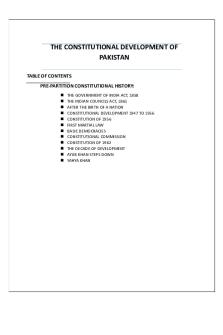
Constitutional History of pakistan
- 16 Pages
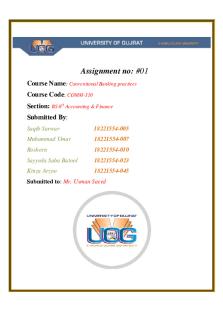
25 Banks of PAKISTAN
- 25 Pages
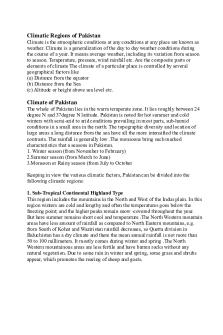
Climatic Regions of Pakistan
- 2 Pages
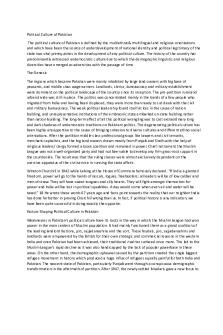
Political culture of Pakistan
- 11 Pages
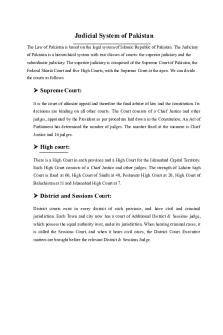
Judicial System of Pakistan
- 2 Pages
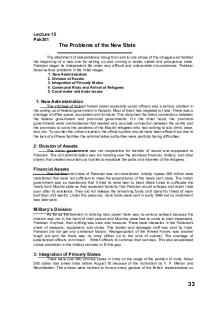
01 Early Problems of Pakistan
- 2 Pages
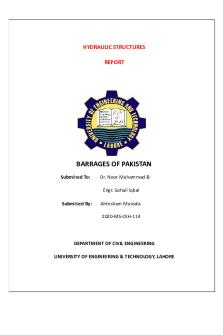
Barrages of Pakistan detail study
- 17 Pages
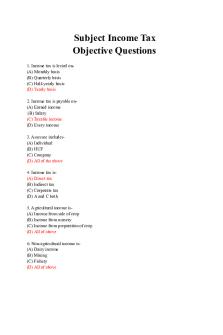
MCQs of Income Tax Pakistan
- 10 Pages
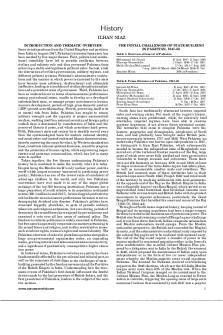
History Of Pakistan 1947-2017
- 15 Pages
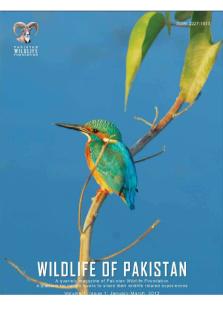
Wildlife of Pakistan Mar 2012
- 62 Pages
Popular Institutions
- Tinajero National High School - Annex
- Politeknik Caltex Riau
- Yokohama City University
- SGT University
- University of Al-Qadisiyah
- Divine Word College of Vigan
- Techniek College Rotterdam
- Universidade de Santiago
- Universiti Teknologi MARA Cawangan Johor Kampus Pasir Gudang
- Poltekkes Kemenkes Yogyakarta
- Baguio City National High School
- Colegio san marcos
- preparatoria uno
- Centro de Bachillerato Tecnológico Industrial y de Servicios No. 107
- Dalian Maritime University
- Quang Trung Secondary School
- Colegio Tecnológico en Informática
- Corporación Regional de Educación Superior
- Grupo CEDVA
- Dar Al Uloom University
- Centro de Estudios Preuniversitarios de la Universidad Nacional de Ingeniería
- 上智大学
- Aakash International School, Nuna Majara
- San Felipe Neri Catholic School
- Kang Chiao International School - New Taipei City
- Misamis Occidental National High School
- Institución Educativa Escuela Normal Juan Ladrilleros
- Kolehiyo ng Pantukan
- Batanes State College
- Instituto Continental
- Sekolah Menengah Kejuruan Kesehatan Kaltara (Tarakan)
- Colegio de La Inmaculada Concepcion - Cebu



